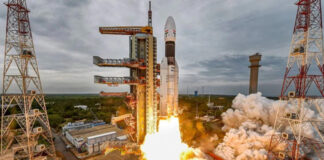DECEMBER 10, 2018
 The Sun sits in an extensive bubble of hot gas called the heliospher.
The Sun sits in an extensive bubble of hot gas called the heliospher.
The Voyager 2 probe, which left Earth in 1977, has become the second human-made object to leave our Solar System.
It was launched 16 days before its twin craft, Voyager 1, but that probe’s faster trajectory meant that it was in “the space between the stars” six years before Voyager 2.
The news was revealed at the American Geophysical Union (AGU) meeting in Washington.
And the chief scientist on the mission, Prof Edward Stone, confirmed it.
He said both probes had now “made it into interstellar space” and that Voyager 2’s date of departure from the Solar System was 5 November 2018.
On that date, the steady stream of particles emitted from the Sun that were being detected by the probe suddenly dipped.
Voyager 2 present location is some 18 billion km (11 billion miles) from Earth. It is moving at roughly 54,000km/h (34,000mph; with respect to the Sun).
Voyager 1 is further and faster still, at 22 billion km and 61,000km/h.
Did the the team plan to explore beyond the Solar System?
The Voyagers were sent initially to study the outer planets, but then just kept on going.
Prof Stone said that at the start of the mission the team had no idea how long it would take them to reach the edge of the heliosphere – the bubble of particles and magnetic field from our Sun.
“We didn’t even know how long a spacecraft could operate for,” he added. “Now we’re studying the very local interstellar medium.”
Voyager 1 departed Earth on 5 September 1977, a few days after its sister spacecraft, Voyager 2.
The pair’s primary objective was to survey the planets Jupiter, Saturn, Uranus and Neptune – a task they completed in 1989.
They were then steered towards deep space. It is expected that their plutonium power sources will eventually stop supplying electricity, at which point their instruments and their 20W transmitters will die.
Voyager 1 will not approach another star for nearly 40,000 years, even though it is moving at 45km/s (100,000mph). But it will be in orbit around the centre of our galaxy with all its stars for billions of years.
Courtesy/Source: BBC News

































































































